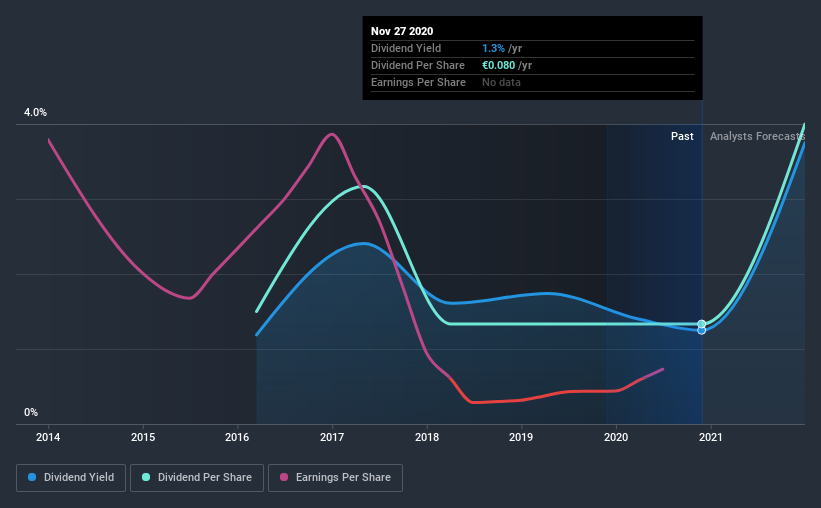How Does aktsiaselts Linda Nektar (TAL:LINDA) Fare As A Dividend Stock?

Is aktsiaselts Linda Nektar (TAL:LINDA) a good dividend stock? How can we tell? Dividend paying companies with growing earnings can be highly rewarding in the long term. On the other hand, investors have been known to buy a stock because of its yield, and then lose money if the company's dividend doesn't live up to expectations.
With a 1.3% yield and a five-year payment history, investors probably think aktsiaselts Linda Nektar looks like a reliable dividend stock. While the yield may not look too great, the relatively long payment history is interesting. Before you buy any stock for its dividend however, you should always remember Warren Buffett's two rules: 1) Don't lose money, and 2) Remember rule #1. We'll run through some checks below to help with this.
Explore this interactive chart for our latest analysis on aktsiaselts Linda Nektar!

Payout ratios
Companies (usually) pay dividends out of their earnings. If a company is paying more than it earns, the dividend might have to be cut. As a result, we should always investigate whether a company can afford its dividend, measured as a percentage of a company's net income after tax. aktsiaselts Linda Nektar paid out 426% of its profit as dividends, over the trailing twelve month period. Unless there are extenuating circumstances, from the perspective of an investor who hopes to own the company for many years, a payout ratio of above 100% is definitely a concern.
Another important check we do is to see if the free cash flow generated is sufficient to pay the dividend. Unfortunately, while aktsiaselts Linda Nektar pays a dividend, it also reported negative free cash flow last year. While there may be a good reason for this, it's not ideal from a dividend perspective.
With a strong net cash balance, aktsiaselts Linda Nektar investors may not have much to worry about in the near term from a dividend perspective.
We update our data on aktsiaselts Linda Nektar every 24 hours, so you can always get our latest analysis of its financial health, here.
Dividend Volatility
From the perspective of an income investor who wants to earn dividends for many years, there is not much point buying a stock if its dividend is regularly cut or is not reliable. Looking at the data, we can see that aktsiaselts Linda Nektar has been paying a dividend for the past five years. During the past five-year period, the first annual payment was €0.09 in 2015, compared to €0.08 last year. This works out to be a decline of approximately 2.3% per year over that time. aktsiaselts Linda Nektar's dividend has been cut sharply at least once, so it hasn't fallen by 2.3% every year, but this is a decent approximation of the long term change.
We struggle to make a case for buying aktsiaselts Linda Nektar for its dividend, given that payments have shrunk over the past five years.
Dividend Growth Potential
With a relatively unstable dividend, it's even more important to see if earnings per share (EPS) are growing. Why take the risk of a dividend getting cut, unless there's a good chance of bigger dividends in future? aktsiaselts Linda Nektar's EPS have fallen by approximately 39% per year during the past five years. With this kind of significant decline, we always wonder what has changed in the business. Dividends are about stability, and aktsiaselts Linda Nektar's earnings per share, which support the dividend, have been anything but stable.
Conclusion
To summarise, shareholders should always check that aktsiaselts Linda Nektar's dividends are affordable, that its dividend payments are relatively stable, and that it has decent prospects for growing its earnings and dividend. aktsiaselts Linda Nektar paid out almost all of its cash flow and profit as dividends, leaving little to reinvest in the business. Earnings per share are down, and aktsiaselts Linda Nektar's dividend has been cut at least once in the past, which is disappointing. In this analysis, aktsiaselts Linda Nektar doesn't shape up too well as a dividend stock. We'd find it hard to look past the flaws, and would not be inclined to think of it as a reliable dividend-payer.
Investors generally tend to favour companies with a consistent, stable dividend policy as opposed to those operating an irregular one. Still, investors need to consider a host of other factors, apart from dividend payments, when analysing a company. Just as an example, we've come accross 3 warning signs for aktsiaselts Linda Nektar you should be aware of, and 1 of them doesn't sit too well with us.
Looking for more high-yielding dividend ideas? Try our curated list of dividend stocks with a yield above 3%.
If you’re looking to trade aktsiaselts Linda Nektar, open an account with the lowest-cost* platform trusted by professionals, Interactive Brokers. Their clients from over 200 countries and territories trade stocks, options, futures, forex, bonds and funds worldwide from a single integrated account. Promoted
New: AI Stock Screener & Alerts
Our new AI Stock Screener scans the market every day to uncover opportunities.
• Dividend Powerhouses (3%+ Yield)
• Undervalued Small Caps with Insider Buying
• High growth Tech and AI Companies
Or build your own from over 50 metrics.
This article by Simply Wall St is general in nature. It does not constitute a recommendation to buy or sell any stock, and does not take account of your objectives, or your financial situation. We aim to bring you long-term focused analysis driven by fundamental data. Note that our analysis may not factor in the latest price-sensitive company announcements or qualitative material. Simply Wall St has no position in any stocks mentioned.
*Interactive Brokers Rated Lowest Cost Broker by StockBrokers.com Annual Online Review 2020
Have feedback on this article? Concerned about the content? Get in touch with us directly. Alternatively, email editorial-team@simplywallst.com.
About TLSE:LINDA
aktsiaselts Linda Nektar
Produces and sells ferments, cider, and fruit wines for the beverages industry in Estonia, Finland, Latvia, Lithuania, Spain, Kenya, the United Kingdom, and rest of European Union countries.
Adequate balance sheet slight.


